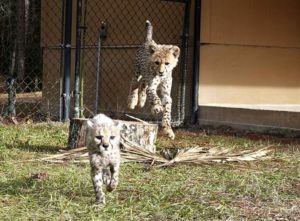White Oak Conservation
Press Release
January 5, 2010
One-month-old male born at Cincinnati Zoo’s breeding facility is united with White Oak cub

Yulee, Fla. (Dec. 30, 2019) — White Oak Conservation and the Cincinnati Zoo & Botanical Garden have brought together two cheetah cubs, born two months apart to single litters, to ensure they have companionship and confidence.
Gomez, a male born Nov. 1 at Cincinnati Zoo’s Mast Farm, arrived this month at White Oak, a wildlife refuge in northeastern Florida owned by philanthropists Mark and Kimbra Walter. White Oak’s cub, a female named Morticia, was born Sept. 27.
The two cubs are being hand-reared because cheetah mothers generally will not raise one offspring, called a singleton. Typically in the wild, the mother will let a singleton cub die, in order to breed again with the goal of producing a larger litter.
“Adult female cheetahs need to maximize their reproductive potential because they usually spend about 18 months raising their cubs before they breed again,” said Brandon Speeg, White Oak’s director of conservation. “But, as a refuge that works to save threatened species, we do not abandon these newborn animals. We hand-rear any singletons.”
The cubs will grow up together at White Oak and stay together for one to two years before separating to breed. As they grow accustomed to each other, the caregivers introduce them into the same habitat.
“Young animals, including cheetah cubs, learn important skills through play,” said White Oak CEO Steve Shurter. “White Oak’s large cheetah population also allows us to keep the cubs within visual contact of adult cheetahs, helping them learn proper social cues.”
Cheetahs are a threatened species, with fewer than 7,000 estimated to live in the wild in Africa and Iran. Their numbers have declined drastically as a result of poaching, habitat loss, the illegal pet trade and because of ranchers, who trap and shoot them to protect livestock.
“Cheetahs are perilously close to extinction,” said Mark Walter, who co-leads Walter Conservation, of which White Oak is a centerpiece, with his wife, Kimbra. “They are already almost extinct in Asia with only 50 estimated to be remaining in a small pocket of Iran. Unsurprisingly, it is humans’ fault, and I join with other conservationists in calling for the species’ status to be changed from ‘vulnerable’ to ‘endangered,’ which will open new funding streams and support.”
Cheetahs first arrived at White Oak in 1985. Since then, 188 cubs in 53 litters have been born at the refuge.
Walter Conservation works to save endangered species and preserve large, wild spaces across the globe. Habitat preservation is just as, if not more, critical to species survival; sufficient loss is proven to lead to extinction. This is why the Walters have purchased ranches and reserves from Texas to Africa, protecting them from further development and managing them in ways that speed species recovery.
White Oak pioneers global conservation efforts through innovative science; breeding; species reintroduction; education programs; and collaborations with other conservation groups and governments. The refuge hosted a cheetah conference last year, drawing experts from around the world to share information and strategies on preserving this vulnerable species.
”Cincinnati Zoo is so excited that White Oak is able to give Gomez a sibling with whom to grow up and share in all the new and exciting cheetah milestones,” said Christina Gorsuch, Cincinnati Zoo curator of mammals. “Thanks to our experienced cheetah staff and neonate keeper, we were able to keep him healthy and strong until he could be picked up by White Oak. Our experience, hand-rearing 19 cheetah cubs since 2008, allows us to support the cheetah Species Survival Plan here and throughout the country at other cheetah facilities.”
Facts about cheetahs:
Cheetahs are the fastest land animals, employing incredible bursts of speed in 60 to 70 mph runs to catch antelope, hares or birds.
To communicate, cheetahs make a high-pitched chirping sound that sounds almost bird-like.
Cheetah litter sizes typically range from three to five cubs
Female cheetahs separate themselves and live solitary lives, while males stay together in groups called coalitions.
About White Oak Conservation
White Oak is part of Walter Conservation, led by Kimbra and Mark Walter, which works to save endangered species and preserve wild places in many countries. White Oak pioneers global conservation efforts through innovative science; breeding; species reintroduction; education programs; and collaborations with other conservation groups and governments. White Oak’s 17,000 riverfront acres in northeast Florida provide a refuge for more than 17 endangered species.
